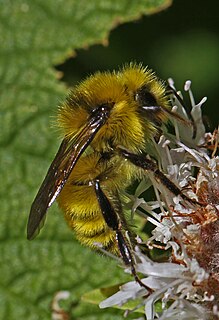
Trophallaxis is the transfer of food or other fluids among members of a community through mouth-to-mouth (stomodeal) or anus-to-mouth (proctodeal) feeding. Along with nutrients, trophallaxis can involve the transfer of molecules such as pheromones, organisms such as symbionts, and information to serve as a form of communication. Trophallaxis is used by some birds, gray wolves, vampire bats, and is most highly developed in social insects such as ants, wasps, bees, and termites.

Halictidae is the second-largest family of bees. Halictid species occur all over the world and are usually dark-colored and often metallic in appearance. Several species are all or partly green and a few are red; a number of them have yellow markings, especially the males, which commonly have yellow faces, a pattern widespread among the various families of bees. The family is distinguished by the arcuate basal vein found on the wing.

Lasioglossum zephyrus is a sweat bee of the family Halictidae, found in the U.S. and Canada. It appears in the literature primarily under the misspelling "zephyrum". It is considered a primitively eusocial bee, although it may be facultatively solitary. The species nests in burrows in the soil.

Lasioglossum vierecki, also known as Dialictus vierecki and Halictus vierecki, is a sand sweat bee and is part of the family Halictidae of the order Hymenoptera. It is found in the eastern half of North America from Minnesota to the New England States down to Georgia and Louisiana and up in Manitoba and Ontario. Commonly found in sandy areas, it pollinates various flowers such as grass-leaved goldenrod and rattlesnake master.

Dialictus is a subgenus of sweat bees belonging to the genus Lasioglossum. Most of the members of this subgenus have a metallic appearance, while some are non-metallic. There are over 630 species worldwide. They are commonly found in the Northern Hemisphere and are found in abundance in North America. Members of this subgenus also have very diverse forms of social structure making them model organisms for studying the social behavior of bees.

The hawthorn miner bee is a species of miner bee in the family Andrenidae which is in the order Hymenoptera. Another common name for this species is hawthorn andrena. It is found in North America.
Crabro villosus is a species in the order Hymenoptera, in the class Insecta ("insects"). It is found in North America.

Andrena krigiana is a species in the family Andrenidae, in the order Hymenoptera. The species is known generally as the "dwarf-dandelion andrena". It is found in North America.
Stictiella formosa is a species in the order Hymenoptera, in the class Insecta ("insects"). The distribution range of Stictiella formosa includes Central America and North America.

Triepeolus is a genus of cuckoo bees in the family Apidae. There are at least 140 described species in Triepeolus.
Lasioglossum pilosum is a species of sweat bees in the family Halictidae. The species is a generalist and known to pollinate flowers as well as commercial fruits like apples.sometimes known to cause slightly irritating sting mild in comparison to most other stinging bee species

Bombus vandykei, the Van Dyke's bumble bee, is a species of bumble bees in the family Apidae. It is found in North America.
Stelis perpulchra is a species of insect in the family Megachilidae. It is found in Central America and North America.
Lasioglossum petrellum is a species of sweat bee in the family Halictidae.

Dryocosmus imbricariae, the banded bullet gall wasp, is a species of gall wasp in the family Cynipidae.

Dufourea is a genus of sweat bees in the family Halictidae. There are at least 160 described species in Dufourea.

Augochlorella is a genus in the bee family Halictidae, commonly called sweat bees. They display metallic coloration, ranging from reddish to gold to bluish green, as is typical for other genera in the tribe Augochlorini.

Stelis is a genus of kleptoparasitic bees in the family Megachilidae. There are at least 100 described species in Stelis.
Lasioglossum olympiae is a species of sweat bee in the family Halictidae.

Agathis is a genus of braconid parasitoid wasps. This genus was established by Latreille in 1804, and the type species is Agathis malvacearum Latreille, 1805. There are at least forty six species of Agathis in the western palearctic region.













